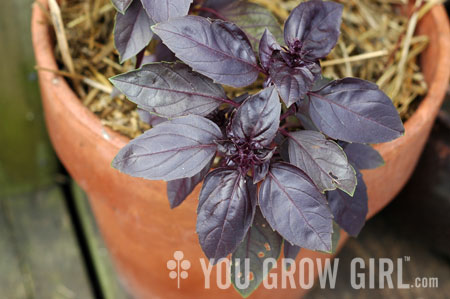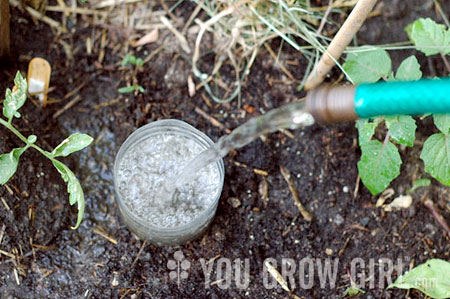
The following article was printed over the weekend as a part of my food gardening series in The Globe & Mail. Summer has been a late arrival around these parts — heavy rains and thunderstorms have been in the forecast regularly since spring. It’s been great in some ways since many of my plants are lush, and the cool season crops are continuing to produce well past their season.
On the other hand, the basil is a lot smaller than usual and even the indeterminate (vining) tomatoes appear to be slightly shorter than I remember them around this time in other years. My biggest worry is the ‘West Indian Sour Gherkin’. It is alarmingly tiny and appears to be laying in wait for some real heat to make it grow.
Despite the fact that today’s forecast is calling for rain, we are beginning to experience a shift towards higher temperatures with a reduction in wind. And as you’ll read, containers dry out quickly regardless of how much rain is in the forecast. A couple of days of intense sun can put the roof garden on high alert for drought conditions.
And as for the pepper plant that I mention in the second paragraph? I found it in a similarly withered state yesterday afternoon (it was very hot on the roof) and have since repotted it into a much larger container.
I do try and take my own advice, sometimes.
———————————–
Nature has been minding the gardens for me this spring. Cool, wet conditions have significantly reduced my usual watering routine, even on the roof where a trifecta of sun, heat, and wind conspire to create a sometimes-punishing state of affairs.
It’s been easy, too easy really — I’d nearly forgotten what it is supposed to be like at this time of year until I plodded outside one afternoon and discovered my most prized variegated hot pepper plant completely collapsed and withered in its pot.
With some fast action on my part and the plant was standing upright again within the hour. Crisis averted. But that’s not to say that it wasn’t affected.
On the whole, food gardens tend to be more vulnerable to drought than their ornamental cousins. If the soil is too dry, too often, plants stress out and become susceptible to insects and disease.
Fruit producers including tomatoes, cucumbers and squash require more water, especially when they start to set fruit. They’ll grow dry, hard, undersized, or not at all without adequate moisture to sustain the watery fruit. Herbs and leafy greens rush to produce seed too quickly, and grow tough and bitter tasting.
Newly planted seedlings and seeds are even more demanding than mature plants. This is one reason why most vegetable planting comes to a halt during the hottest part of the summer. If you do need to plant during a drought, dig a hole and fill it up with water. Wait for the water to sink in and fill the hole again before planting as usual. Saturating the soil beforehand will keep the soil moist longer and support the seedling as it gets established.

‘Red Rubin’ basil planted in a big pot with a thick layer of mulch on top.
Container gardens are notoriously water hungry, sometimes requiring a good drink as much as twice a day during a heat wave. Gardening in plastic pots instead of terracotta and using big pots instead of small will prevent the kind of catastrophe my pepper endured. Add a thick layer of mulch using straw, grass, or shredded paper to the top of pots to create a cooling, protective barrier against the drying effects of the sun and wind.
In-ground gardens don’t dry out as quickly as containers and will reap the same benefits from a mulch blanket. You can further reduce your need to water by adding lots of compost to the garden since loamy, crumbly, soil retains water well.

This determinate (bush) tomato is planted in a big pot with a drip irrigation system and mulch applied to the surface.
How you water can actually impact how often you need to do it. Drip and slow-flow irrigation systems such as soaker hoses distribute water slowly, allowing the soil and plants to soak everything in right at the roots where moisture is needed most. Lee Valley sells affordable watering spikes that slowly release water deep in the soil from an attached water bottle reservoir. These are handy for weekends away! You can make your own by drilling tiny holes into the cap and sides of a used water bottle. Cut off the top (like a funnel) and bury it cap-side down right next to the roots of your water-hungry tomatoes.

This device also serves as a great reminder to direct the stream of water at the soil and not up into the air or on the leaves of your plants. Watering this way creates excess humidity around dense foliage — the perfect breeding ground for fungus and blight. It also means that while the foliage is damp, the soil may be too dry.
When you do water, always give the soil and roots a good, deep drink. Your plant (including the roots) will grow healthier and more productive for it and will inevitably be more disease, pest, and drought resistant as a result.
Sounds like your weather has been like ours, here in Tennessee. I put down our soaker hoses last week, knowing that soon enough the rain will stop and we’ll need them. Although we just had spring-like thunderstorms this past weekend…..in July!
Very timely article — I just noticed my first tomato fruit succumbed to blossom end rot because of inconsistent watering. I’m going to make irrigators this week, though I’m not sure where to get the bottles, since I don’t drink soda… Quick question: Do you ever have to worry about mosquitoes breeding in the open funnels?
Rapunzel: I don’t drink soda either… can be any beverage bottle. Friends will be happy to give you some from their recycling.
I have never had a problem with mosquitoes… they don’t release the water THAT slowly.
Just curious, Gayla: I have Plant Nannies, but the Lee Valley spikes are way cheaper. Have you tried the Plant Nannies? What are the pros and cons? To me, the ceramic base of the Plant Nanny seems like it would be less likely to clog. But then there’s the price… :-(
Have the spikes ever clogged or do they generally work okay, hold water well, etc?
PS Rapunzel, if you’re in Toronto, almost anybody will be happy to give you their recycling right about now!!! :-)))
Jennifer: I have not tried Plant Nannies. I have not had problems with clogging but others have.
Thanks, Jennifer, but I’m in Philly. We have the pleasure of watching our recylables roll away weekly.
Fine to see the spikes here, too! I’ve been using them on my balcony througout this season whenever I had to spend 1-2 days abroad. Cheap but effective.
Unfortunately & inspite of the tiny holes they’ll still let the water drip too fast. My idea was to apply two bottles (e. g. for my very thirsty tomato plant): one with a spike as it comes out of the package and one with a spike where I blocked all but the two smallest of the holes.
Still not perfect, but definitely some improvement!